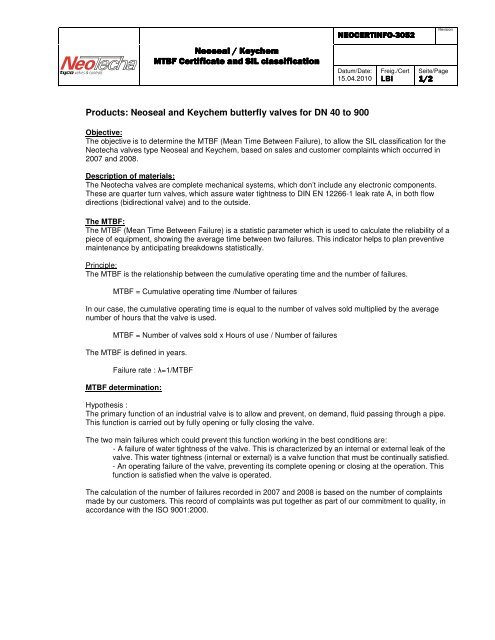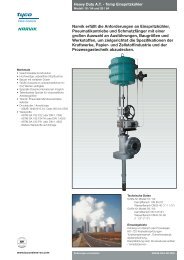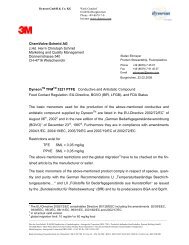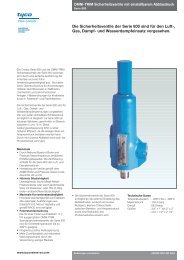Keychem Butterfly Valves - Avintos
Keychem Butterfly Valves - Avintos
Keychem Butterfly Valves - Avintos
Create successful ePaper yourself
Turn your PDF publications into a flip-book with our unique Google optimized e-Paper software.
Neoseal Neoseal / / / <strong>Keychem</strong><br />
<strong>Keychem</strong><br />
MTBF MTBF MTBF Certificate Certificate and and SIL SIL classification<br />
classification<br />
NEOCERTINFO<br />
NEOCERTINFO-3052<br />
NEOCERTINFO 3052<br />
Datum/Date:<br />
15.04.2010<br />
Products: Neoseal and <strong>Keychem</strong> butterfly valves for DN 40 to 900<br />
Freig./Cert<br />
LBI<br />
Revision<br />
Seite/Page<br />
1/2<br />
Objective:<br />
The objective is to determine the MTBF (Mean Time Between Failure), to allow the SIL classification for the<br />
Neotecha valves type Neoseal and <strong>Keychem</strong>, based on sales and customer complaints which occurred in<br />
2007 and 2008.<br />
Description of materials:<br />
The Neotecha valves are complete mechanical systems, which don’t include any electronic components.<br />
These are quarter turn valves, which assure water tightness to DIN EN 12266-1 leak rate A, in both flow<br />
directions (bidirectional valve) and to the outside.<br />
The MTBF:<br />
The MTBF (Mean Time Between Failure) is a statistic parameter which is used to calculate the reliability of a<br />
piece of equipment, showing the average time between two failures. This indicator helps to plan preventive<br />
maintenance by anticipating breakdowns statistically.<br />
Principle:<br />
The MTBF is the relationship between the cumulative operating time and the number of failures.<br />
MTBF = Cumulative operating time /Number of failures<br />
In our case, the cumulative operating time is equal to the number of valves sold multiplied by the average<br />
number of hours that the valve is used.<br />
MTBF = Number of valves sold x Hours of use / Number of failures<br />
The MTBF is defined in years.<br />
Failure rate : λ=1/MTBF<br />
MTBF determination:<br />
Hypothesis :<br />
The primary function of an industrial valve is to allow and prevent, on demand, fluid passing through a pipe.<br />
This function is carried out by fully opening or fully closing the valve.<br />
The two main failures which could prevent this function working in the best conditions are:<br />
- A failure of water tightness of the valve. This is characterized by an internal or external leak of the<br />
valve. This water tightness (internal or external) is a valve function that must be continually satisfied.<br />
- An operating failure of the valve, preventing its complete opening or closing at the operation. This<br />
function is satisfied when the valve is operated.<br />
The calculation of the number of failures recorded in 2007 and 2008 is based on the number of complaints<br />
made by our customers. This record of complaints was put together as part of our commitment to quality, in<br />
accordance with the ISO 9001:2000.
Neoseal Neoseal / / <strong>Keychem</strong><br />
<strong>Keychem</strong><br />
MTBF MTBF Certificate Certificate and and SIL SIL classification<br />
classification<br />
classification<br />
NEOCERTINFO<br />
NEOCERTINFO-3052<br />
NEOCERTINFO 3052<br />
Datum/Date:<br />
15.04.2010<br />
Freig./Cert<br />
LBI<br />
Revision<br />
Seite/Page<br />
2/2<br />
MTBF calculation for a failure of water tightness of the valve:<br />
For this calculation, we assume that a valve works continually for its water tightness function, this represents<br />
8 760 hours in one year and so 17 520 hours for the corresponding period.<br />
Furthermore, we considered that 80% of the valves sold are actually installed.<br />
MTBF Water tightness = Number of valves sold x 0,80 x Hours of use / Number of failures<br />
MTBF Water tightness = 118808960 hours = 13562 years<br />
Hourly failure rate λ=1/MTBF = 8.4 -09 which is compatible with SIL level 4<br />
MTBF calculation for an operating failure of the valve:<br />
For this calculation, we assume that a valve executes 20 000 cycles per year, the length of a cycle is 5<br />
seconds. This corresponds to a length of use of 27,7 hours per year, ie 55,4 hours for the period in question.<br />
Furthermore, we considered that 80% of the valves sold are actually installed.<br />
MTBF Operation = Number of sold valves x 0,80 x Hours number of use / Number of failures<br />
MTBF Operation = 375685 hours = 42.9 years<br />
Hourly failure rate λ=1/MTBF = 2.7 -06<br />
In this situation, the PFD “Probability of Failure on Demand” is calculated as follows:<br />
The hourly failure rate “valve operation” is 2.7 -06 .<br />
PFD = 2.7 -06 x 27,7 = 7.3 -05 which is compatible with SIL level 4<br />
Safety Integrity Level<br />
NEOTECHA AG<br />
Lars Bieri<br />
Quality Manager<br />
SIL 4 10 -9 < λ < 10 -8<br />
SIL 3 10 -8 < λ < 10 -7<br />
SIL 2 10 -7 < λ < 10 -6<br />
SIL 1 10 -6 < λ < 10 -5<br />
Hombrechtikon, 15.04. 2010<br />
Security Level<br />
Function failure annual probability<br />
Continual operation Operation on demand<br />
Failure probability at moment<br />
Hourly failure rate<br />
of use<br />
10 -5 < PFDavg < 10 -4<br />
10 -4 < PFDavg < 10 -3<br />
10 -3 < PFDavg < 10 -2<br />
10 -2 < PFDavg < 10 -1







